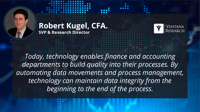I was invited to sit on a panel at CFO 3.0 events held in San Francisco and New York hosted by Sage Intacct. This event is about the evolution of the role that started with the archetypal CFO 1.0, the green-eye-shade-wearing bean counter. Lacking usable technology, he or she was limited to keeping the books in good order and simply reporting what just happened. Today’s CFO 2.0 relies on technology developed over the past two decades as well as the broader perception of the role, catalyzed by...
Read More
Topics:
Office of Finance,
Financial Performance Management,
Price and Revenue Management,
ERP and Continuous Accounting,
robotic finance,
Predictive Planning,
revenue and lease accounting
Ventana Research recently announced its 2020 research agenda for the Office of Finance, continuing the guidance we’ve offered for nearly two decades on the practical use of technology for the finance and accounting department to help these organizations derive greater value and improve their performance. For decades organizations have discussed transforming Finance from a backward-looking “bean counter” to a more strategic advisory role — yet little has changed. One important reason is that the...
Read More
Topics:
Office of Finance,
Price and Revenue Management,
ERP and Continuous Accounting,
robotic finance,
Predictive Planning,
revenue and lease accounting
Yes, it’s an easy metaphor, but a worthwhile one to consider. For the Office of Finance, figures are its raw material. They are transformed and assembled into financial statements, forecasts and reports. Like a factory, there are blueprints (accounting standards, models and forms) that show how the parts are to be pieced together. There’s quality control in the form of internal audit. And there are final inspections — external audits — to ensure the end product has been assembled properly.
Read More
Topics:
Office of Finance,
Financial Performance Management,
Price and Revenue Management,
ERP and Continuous Accounting,
robotic finance,
Predictive Planning,
revenue and lease accounting












